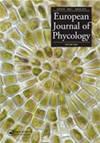东北大西洋钙化藻从前缘到尾缘的生理特征
IF 1.7
4区 生物学
Q2 MARINE & FRESHWATER BIOLOGY
引用次数: 2
摘要
摘要潮间带大型藻类暴露于许多生物和非生物压力源中,包括盐度、温度、pH和太阳辐射等环境参数的显著波动。这项研究对大西洋东北部潮间带钙化红藻珊瑚的种群进行了表征。检查的过程包括初级生产、呼吸、明暗钙化、光合作用辐照度和钙化辐照度的演变。结果证实,在南北梯度明显的纬度之间,巴戟天的生理学存在显著差异。与该物种的中部和南部种群相比,北部种群似乎是最健壮的,显示出当地生理适应的潜力,以应对其栖息地内环境因素变化的增加。相反,与北方人口相比,南方人口明显缺乏当地适应能力。这可能是因为南方种群所处的环境处于其抗压能力的上限,因此限制了物种的适应能力。因此,未来东北大西洋南部地区的C.officinalis可能会永久性减少,甚至消失,这一过程可能会因预测的未来气候变化而加速。此外,考虑到这些生态系统工程师在其栖息地内发挥的重要作用,预计C.officinalis的任何损失也会对周围环境产生强烈的负面影响。珊瑚的光合作用和钙化的解耦。officinalis表现出复杂的关系,而不是直接的依赖关系。北方药用C.officinalis种群的大多数生理特征与中部和南部地区有显著差异。物种的适应主要是适应较低的光照和温度条件。本文章由计算机程序翻译,如有差异,请以英文原文为准。
Physiological characterisation of the calcified alga Corallina officinalis (Rhodophyta) from the leading to trailing edge in the Northeast Atlantic
Abstract Intertidal macroalgae are exposed to many biotic and abiotic stressors, including significant fluctuations in environmental parameters such as salinity, temperature, pH and solar radiation. This study characterized populations of the intertidal calcifying red alga Corallina officinalis across its geographic distribution in the North-east Atlantic. Processes examined included primary production, respiration, light and dark calcification, photosynthesis-irradiance, and calcification-irradiance evolution. Results confirmed significant differences in the physiology of C. officinalis between latitudes with a clear north-to-south gradient. Compared with central and southern populations of this species, northern populations appeared to be the most robust, showing potential for local physiological adaptation in response to increased variability in environmental factors present within their habitat. Conversely, southern populations displayed a distinct lack of local adaptation compared with northern populations. This is possibly due to southern populations being located within an environment at the upper limit of their stress tolerance, therefore restricting the species’ ability to adapt. As a result, future permanent decline, or even disappearance, of C. officinalis within southern locations of the North-east Atlantic could occur, a process that is likely to be accelerated by predicted future climatic changes. Furthermore, given the essential role these ecosystem engineers play within their habitat, any loss of C. officinalis is also expected to have a strongly negative impact on the surrounding environment. HIGHLIGHTS Decoupled photosynthesis and calcification in Corallina. officinalis show complex relationships, not direct dependencies. Most physiological characteristics in northern C. officinalis populations differ significantly from those in central and southern locations. Species adaptation is predominantly to lower light and temperature conditions.
求助全文
通过发布文献求助,成功后即可免费获取论文全文。
去求助
来源期刊

European Journal of Phycology
生物-海洋与淡水生物学
CiteScore
4.80
自引率
4.20%
发文量
37
审稿时长
>12 weeks
期刊介绍:
The European Journal of Phycology is an important focus for the activities of algal researchers all over the world. The Editors-in-Chief are assisted by an international team of Associate Editors who are experts in the following fields: macroalgal ecology, microalgal ecology, physiology and biochemistry, cell biology, molecular biology, macroalgal and microalgal systematics, applied phycology and biotechnology. The European Journal of Phycology publishes papers on all aspects of algae, including cyanobacteria. Articles may be in the form of primary research papers and reviews of topical subjects.
The journal publishes high quality research and is well cited, with a consistently good Impact Factor.
 求助内容:
求助内容: 应助结果提醒方式:
应助结果提醒方式:


